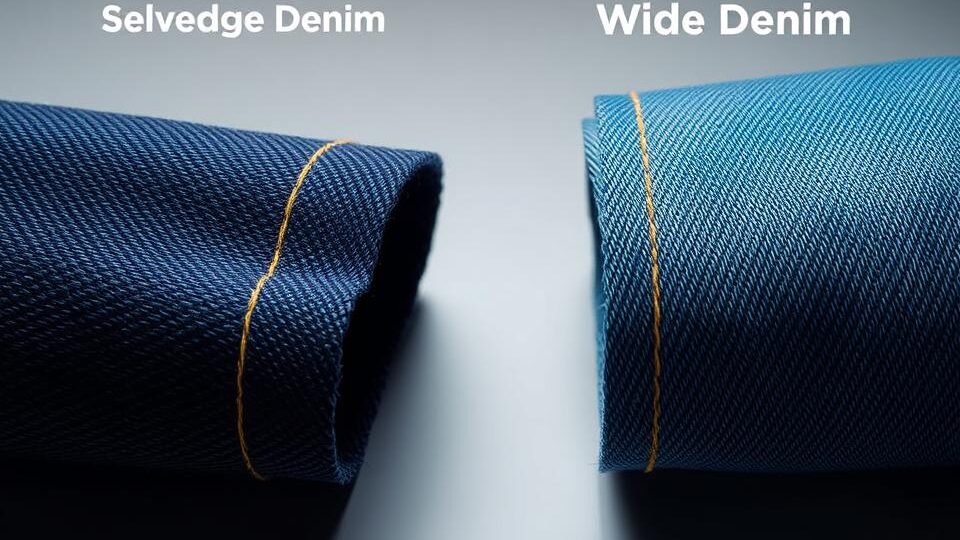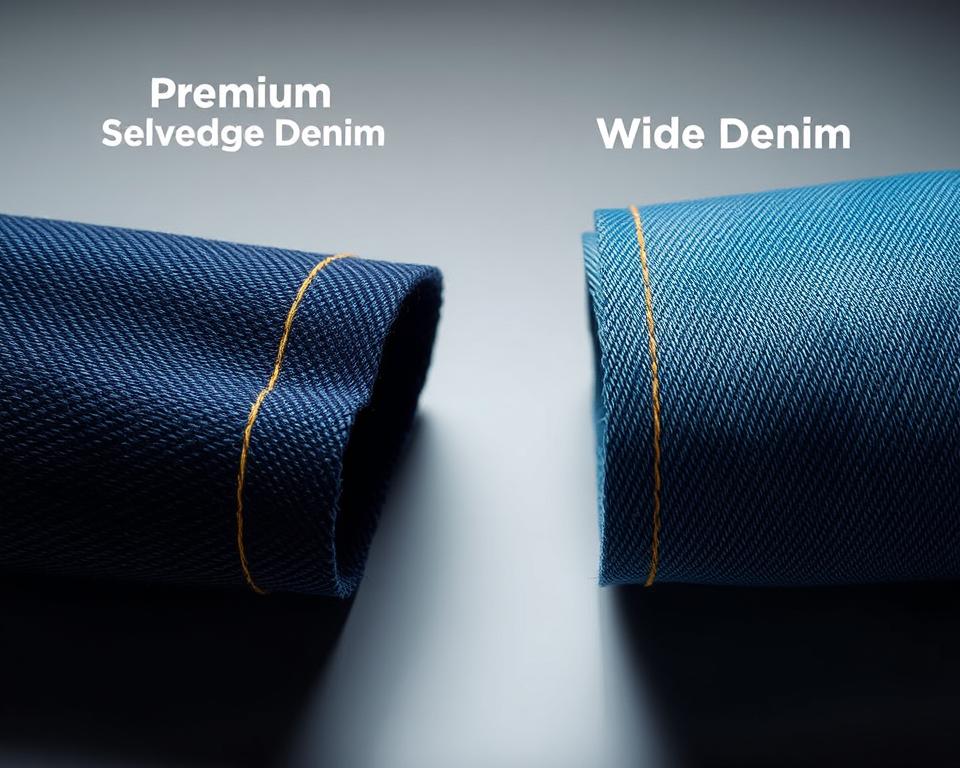
Understanding Minimum Order Quantities for Selvedge Denim By The Yard
A Comprehensive Handbook to High-Quality denim Selvedge Material
Ever pondered the reason some pants feel as though they are built for endurance the ages? Everything revolves around the elements and skill. For example, the rising popularity of high-end selvedge. This goes beyond common fabric—it attests to excellence and tradition.
Nowadays, more people are choosing these classic textiles for their durability and traditional selvedge denim by the yard charm. Whether you’re a home sewing sewist or a denim lover, there’s something special about working with high-quality cotton and thread. It’s not just about creating pants; it centers on fashioning a legacy.
Within Core Fabrics, we’ve selected a collection of 14.25oz certified organic cotton and flexible options. These materials are tailor-made for all from raw jeans to couture jacket blueprints. Prepared to dive into the world of top-tier fabrics? Let us delve in.
What Is Denim Selvedge Fabric?
What makes certain trousers stand out with their distinctive, self-finished seams? The key lies in the selvedge denim, a superior material known for its robustness and vintage aesthetic. Differing from conventional textiles, this fabric is produced using traditional methods that have endured through ages.
What Selvedge Denim Means
Selvedge denim is created via retro shuttle looms, which yield minimal widths of about 30-35 inches. They intertwine the fabric in a way that creates self-finished seams, often marked by a distinctive red line. This process ensures the textile is densely interlaced and exceptionally sturdy.
Current looms, alternatively, produce broader material but lack the same level of craftsmanship. Minor flaws in selvedge, like leg twists or uneven textures, are accepted as part of its charm. This ideology, often referred to as “the beauty of imperfection”, honors the appeal of inherent flaws.
Production of Selvedge Denim
The creation of selvedge denim involves a exacting process. Traditional shuttle looms weave the weft thread alternately, creating a thick and resilient fabric. This method contrasts with contemporary machines, which emphasize speed and efficiency over craftsmanship.
Brands like Karson Denim preserve time-honored Japanese methods from the 1990s. They deliberately incorporate anomalies to retain the genuineness of the textile. All products is evaluated on a four-point system, ensuring it satisfies the top criteria of excellence.
| Characteristic | Selvedge Denim | Contemporary Denim |
|---|---|---|
| Measure | 30-35 inches | 60+ inches |
| Fabrication Method | Shuttle Loom | Modern Loom |
| Surface | Non-uniform, Raw | Uniform |
| Sturdiness | Superior | Moderate |
“The allure of selvedge resides in its natural irregularities—each irregularity speaks of artistry and heritage.”
The History of Selvedge Denim
From humble beginnings to worldwide renown, the tale of these textiles is rich and moving. What started as hardwearing clothing in 17th-century France transformed into a symbol of everlasting fashion and artistry.
Origins in Traditional Weaving
The roots of this textile reaches back to Nîmes, France, where it was known as “serge de Nîmes.” Originally designed for laborers, it was crafted out of hardwearing cotton and stitching. Its strength ensured its popularity among workers during the era of the Gold Rush.
In the 20th century, it had transformed into a staple for jeans. The ending of the Cone Mills White Oak factory became a pivotal moment. This transition enabled Japanese artisans to revive traditional weaving techniques.

Evolution in Modern Denim Production
Post-WWII, Japan developed a deep appreciation for old-school American culture. Craftsmen revitalized classic looms to create genuine reproductions. This dedication to quality guaranteed the continuance of selvedge as a specialty product.
Currently, advancements from Italy and Turkey have introduced sustainable blends and elastic selections. These improvements have expanded the allure of this classic fabric. At Core Fabrics, we gather worldwide, from Montréal to Asia, to offer you the best standards.
“The history of selvedge is a testament to the perennial merit of craftsmanship and legacy.”
Why Choose Selvedge Denim?
Why does selvedge denim shine in the world of premium materials? Its unique qualities and exceptional longevity make it a favorite among lovers and designers alike. Whether you’re sewing trousers or a sharp jacket, this textile delivers a blend of heritage and contemporary charm.
Unique Qualities of Selvedge Fabric
Selvedge denim is renowned for its tight weave, which improves tear resistance and color fading characteristics. Differing from regular textiles, rainbow selvedge denim is crafted using traditional shuttle looms, creating a denser and exceptionally sturdy fabric. This process ensures that each piece has a unique texture and personality.
Here’s what makes it special:
- Textured, firm raw denim offers a contrast to softened, pre-washed stretch fabrics.
- Through sanforization, sizes become reliable, while untreated fabrics provide a unique shrinkage journey.
- Weight options range from 9.5oz Eco Finish to 14.25oz Organic, catering to different needs.
Robustness and Endurance
One of the standout features of selvedge denim is its longevity. The tighter weave boosts robustness while enabling characteristic wear patterns over time. This establishes it as a valuable investment for those in pursuit of classic garments.
Key points to consider:
- Fabrics weighing between 12oz and 14oz are perfect for form-fitting jackets and jeans that mellow with time.
- Opt for the 14.25oz True Indigo for traditional jean lifespan.
- Sustainable variants such as recycled cotton combined with indigo blends enhance eco-friendliness.
Core Fabrics offers an assortment of products tailored for every requirement. Whether untreated or sanforized, every item is made to provide outstanding quality and performance.
Selvedge Denim vs. Wide Denim
When it comes to crafting long-lasting and trendy pieces, the decision of fabric plays a crucial role. Two popular options are selvedge and wide denim, both offering different features. Comprehending their variances guides the right one for your creation.
Distinct Weaving Methods
Selvedge denim is woven on traditional shuttle looms, yielding slim widths of 30-35 inches. This selvedge denim jacket method creates tightly woven edges, often accented with a characteristic red line. In contrast, wide denim is produced using modern projectile looms, yielding widths of 60 inches or more.
Traditional shuttle looms operate at approximately 3 meters per minute, while projectile looms can produce up to 30 meters per minute. The variance in production speed affects both the cost and the finish of the end result.
Benefits and Drawbacks
Selvedge denim is known for its premium quality and durability. Its limited breadth suits it well for applications where defined edges and detail work are sought. However, it can be pricier, generally priced at $23 per meter.
Wide denim is economical, priced around $8 per half-meter. Its broader span reduces waste, making it suitable for extensive endeavors like interior décor projects. However, it falls short of the distinctive selvage detail of selvedge.
| Feature | Selvedge Denim | Wide Denim |
|---|---|---|
| Width | 30-35 inches | 60+ inches |
| Technique | Shuttle Loom | Projectile Loom |
| Production Speed | 3 meters per minute | 30m/min |
| Cost | $23 per meter | $8/half-meter |
For structured edges, like those needed in Grainline Thayer jackets, selvedge is the preferred choice. For larger projects, wide denim offers better value and efficiency. Weigh your requirements carefully to decide.
Working with Selvedge Denim
Utilizing superior fabrics can transform your sewing endeavors. Be it making jeans, blazers, or frocks, knowing how to measure, sew, and care for the material secures expert outcomes. Let’s delve into ways to best utilize this everlasting material.
Fabric Quantities for Your Projects
It is essential to compute the correct fabric amount when designing your creation. Approximately 3-3.3 yards is necessary for men’s jeans, considering defects and shrinkage. Trucker jackets typically require 3.3 yards, while skirts can be made with just 2 yards.
Creative pattern placement can help manage imperfections in the material. Embrace the natural defects by weaving them into your creative design.
| Item | Yardage Needed |
|---|---|
| Men’s Jeans | 3–3.3 yards |
| Trucker-Style Jacket | 3.3 yards |
| Skirt Item | 2 yards |
Advice for Sewing and Longevity
The correct gear and skills secure a refined outcome. Opt for #70-110 needle sizes and presser foot attachments designed for heavy materials. Use Gütermann rPET thread for effective contrast stitching.
Here are some additional tips:
- Use a tailor’s clapper for sharp creases without shine.
- Our denim kits from Core Fabrics comprise topstitch thread, rivets, and 9mm jeans buttons to ensure a refined result.
- For structured edges, like those in jackets, selvedge is the preferred choice.
Correct care ensures your garments last longer. Limit washing and allow to air dry for optimal durability. Following these guidelines guarantees enduring results.
To Summarize
Using superior fabrics goes beyond mere durability—it’s about instilling personality. Selvedge denim embodies this principle, blending artisanal charm with long-lasting quality. From jeans to tailored jackets, every stitch of this material conveys a narrative.
Core Fabrics simplifies your creative journey. Our swatch service lets you touch and test the fabric before deciding. Furthermore, take advantage of free shipping for orders above $150 USD in North America.
Eco-friendly mixtures and classic washes are paving the way for the next generation of cotton fabrics. These trends offer new ways to add sustainability and style to your wardrobe.
Eager to explore top-tier textiles? Begin your journey now and appreciate the merit of intentional crafting. Your next project could be a timeless piece that lasts for years to come.